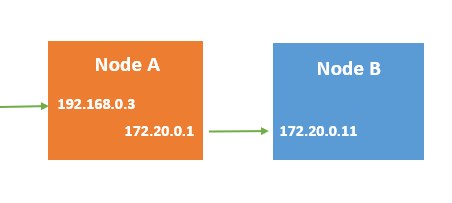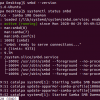Perfect Cheat Sheet for Port Forwarding with iptables
For example, we assume that the packets received at the Node A’s interface “192.168.0.3" will be forwarded from another interface “172.20.0.1" to the destination Node B “172.20.0.11".

Forward From Node A (192.168.0.3) to Node B (172.20.0.11)
In the following example, all packets coming to ports 31000 – 31999 are forwarding to the same ports of Node B.
#TCP
iptables -t nat -I PREROUTING -p tcp -m tcp --dst 192.168.0.3 --dport 31000:31999 -j DNAT --to-destination 172.20.0.11:31000-31999
iptables -t nat -A POSTROUTING -m tcp -p tcp --dst 172.20.0.11 --dport 31000:31999 -j SNAT --to-source 172.20.0.1
iptables -A FORWARD -m tcp -p tcp --dst 172.20.0.11 --dport 31000:31999 -j ACCEPTIf you want to do same things about udp packets, replace “tcp" to “udp" on above commands.
Allow Input Packets
Also, you need to allow those input packets.
##COMMON Allow input packets to 31000:31999 ports
iptables -A INPUT -p tcp -m multiport --dports 31000:31999 -j ACCEPT
iptables -A INPUT -p udp -m multiport --dports 31000:31999 -j ACCEPTAllow Return Packets (Opposite Direction)
In some cases, you need to allow return packets.
iptables -A FORWARD -m state --state ESTABLISHED,RELATED -j ACCEPTHow To Delete iptables’ Entries
If you add wrong entries to the iptables, you can delete them with the following steps.
Step 1. Check rule number.
iptables -L --line-numbersResult example: You can see the rule number at the left of each entry.
$ iptables -L --line-numbers
Chain INPUT (policy ACCEPT)
num target prot opt source destination
1 ACCEPT tcp -- anywhere anywhere multiport dports 31000:34000
2 ACCEPT udp -- anywhere anywhere multiport dports 31000:34000
Chain FORWARD (policy DROP)
num target prot opt source destination
1 DOCKER-USER all -- anywhere anywhere
2 DOCKER-ISOLATION-STAGE-1 all -- anywhere anywhere
3 ACCEPT all -- anywhere anywhere ctstate RELATED,ESTABLISHED
4 DOCKER all -- anywhere anywhere
5 ACCEPT all -- anywhere anywhere
6 ACCEPT all -- anywhere anywhere
7 ACCEPT all -- anywhere anywhere ctstate RELATED,ESTABLISHED
8 DOCKER all -- anywhere anywhere
9 ACCEPT all -- anywhere anywhere
10 ACCEPT all -- anywhere anywhere
11 ACCEPT tcp -- anywhere node_b tcp dpts:31000:31999
12 ACCEPT udp -- anywhere node_b udp dpts:31000:31999Step 2. By using the rule number, delete a rule.
iptables -D [CHAIN NAME] [RULE NUMBER]Example: Delete 11th rule at the “FORWARD" chain.
iptables -D FORWARD 11








Discussion
New Comments
No comments yet. Be the first one!